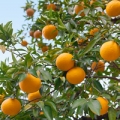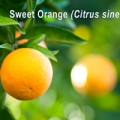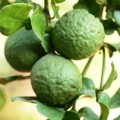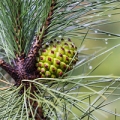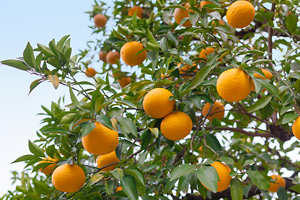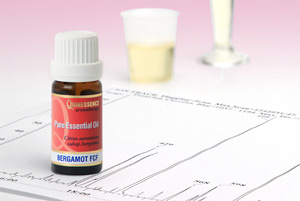Petitgrain essential oil: Wonderful for Peace and Relaxation
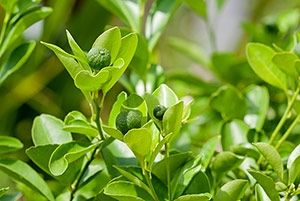 Petitgrain essential oil is derived from the fresh leaves and green twigs of the bitter orange tree (Citrus aurantium) and its various sub-species.
Petitgrain essential oil is derived from the fresh leaves and green twigs of the bitter orange tree (Citrus aurantium) and its various sub-species.
Bitter orange belongs to the Rutaceae family and is believed to have originated in South-East Asia, and spread to North-Eastern India, Burma and China, eventually finding its way via Arab traders to Africa, Arabia and Syria.
From these regions it was taken to the Mediterranean by the Moors and the Crusaders, and by the end of the 12th century it was cultivated in Seville, Spain, thereby leading to the common name for bitter oranges; ‘Seville oranges’. This species was also the first ‘orange’ to reach the New World thanks to the second voyage of Christopher Columbus in 1493.
The vast majority of petitgrain essential oil on the market is derived from Citrus aurantium subsp. amara and is usually identified by its country of origin, for example petitgrain Paraguay or petitgrain Haiti etc. Paraguay is by far the largest producer of petitgrain essential oil and this is the material that is available most commonly from aromatherapy suppliers.
Other than in Paraguay, bitter orange trees are cultivated for the production of petitgrain essential oil in Algeria, Egypt, France, Guinea, Haiti, Italy, Morocco, Spain and Tunisia.
The French connection
French petitgrain was at one time referred to as ‘Petitgrain le bigaradier’, which is a French expression for the ‘bitter orange petitgrain’, but this term has now been largely replaced with the anglicized version, ‘bigarade’. And strictly speaking, only the essential oil extracted from the true bitter orange tree and not any of its sub-species or hybrids should be given the prestigious title of ‘petitgrain bigarade’.
In reality, this particular essential oil is produced in quite limited quantities in Southern France, or from the original French variety cultivated currently in North Africa, Egypt, Italy or Spain. Many suppliers in the aromatherapy market mistakenly call their petitgrain essential oil ‘bigarade’ in the same way that others describe their standard geranium as ‘rose geranium’, which is also a specific variety.
The leaves and twigs of several other citrus species are used to extract a ‘petitgrain’ oil, although these are not commonly found in aromatherapy; lemon petitgrain (Citrus limonum), mandarin petitgrain (Citrus reticulata) and bergamot petitgrain (Citrus aurantium subsp. bergamia) are all commercially produced for other industries.
Also of interest is a relatively uncommon essential oil known as ‘petitgrain bigarade sur fleurs d’oranger’, (or ‘petitgrain sur fleur’ for short) which is a co-distillation of the leaves, petioles, twigs and also the flowers of Citrus aurantium. This essential oil has a more floral aroma than regular petitgrain due to the presence of the orange blossom flowers in the distillation process. These are the same flowers of course that are used to produce neroli essential oil, so you can imagine the contribution they make to the oils aroma.
General description
The bitter orange tree is a small evergreen that reaches a height of about 3 metres (10ft) in cultivation, but may attain up to 6 metres (20ft) when growing in the wild. It has a smooth brown trunk with stout branches, and when compared to the sweet orange tree (Citrus dulcis) it has a tighter crown of leaves and more erect stature. The twigs are flexible with rather blunt thorns, and leaves are broad-ovate, glossy and highly aromatic.
Attractive white flowers consisting of 5 petals and 24 yellow stamens begin to open around April or May and are of course the source material for neroli oil. The golden-yellow sour fruits are round or oval with a thick, heavily pitted skin that yields bitter orange oil by cold expression. The green twigs contain a significant amount of essential oil and it is these, along with the aromatic leaves that are used as the source material for petitgrain essential oil.
Traditional uses
Citrus auranium is quite possibly the most prolific of all essential oil producing trees, providing us with therapeutic essential oils from the fruit, flowers and leaves. And long before the process of distillation had been invented, civilizations around the world were already exploiting the wide range of healing properties yielded from the bark, leaves, flowers, peel and juice of the fruit in folk medicine.
In central and south America, China, Haiti, Italy and Mexico decoctions of the leaves were taken internally for their sudorific, antispasmodic, antiemetic, stimulant, stomachic, tonic effects. Conditions treated included colds, flu, fever, diarrhoea, digestive spasm and indigestion, hemorrhages, infant colic, nausea and vomiting and skin blemishes.
Harvesting and extraction
Trees are pruned every 9 months to maintain optimum foliage, and although harvesting can be at any time, in practice it is usually driven by demand for the essential oil.
Extraction of petitgrain essential oil is by steam distillation using crude but effective stills which produce a pale yellow oil with a wonderful fresh, dry, leafy-citrus fragrance with sweet herbaceous and woody back-notes. Petitgrain bigarade is slightly more floral with reduced woody notes and more reminiscent of neroli, but less sophisticated.
Benefits of pettigrain essential oil
Petitgrain essential oil is surprisingly versatile, and like several other oils it has the ability to both relax and uplift at the same time. In common with neroli, it has an affinity with the skin, helping with acne, pimples and blemishes, balancing over-active sebaceous glands, reducing spider veins, and acting as an all round tonic to the complexion. And all at a much lower price!
Aromatherapists also use petitgrain essential oil for asthma, anxiety, colic, depression, diarrhoea, dyspepsia, fluid retention, greasy skin, headaches and migraine, hay fever, insomnia, mature skin, nausea, nervous exhaustion and stress. As stated, it is a surprisingly versatile essential oil and represents excellent value for money.
Petitgrain oil adds its own unique aromatic and therapeutic qualities wherever you use it, and it is a great middle note for blending. Try it with basil, benzoin, bergamot, clary sage, cypress, geranium, lavender, lemon, lime, linaloe wood, mandarin, neroli, orange sweet, palmarosa, rosemary, sandalwood and ylang ylang.
Browse Quinessence Petitgrain Essential Oil
Copyright © Quinessence Aromatherapy Ltd 2021.

